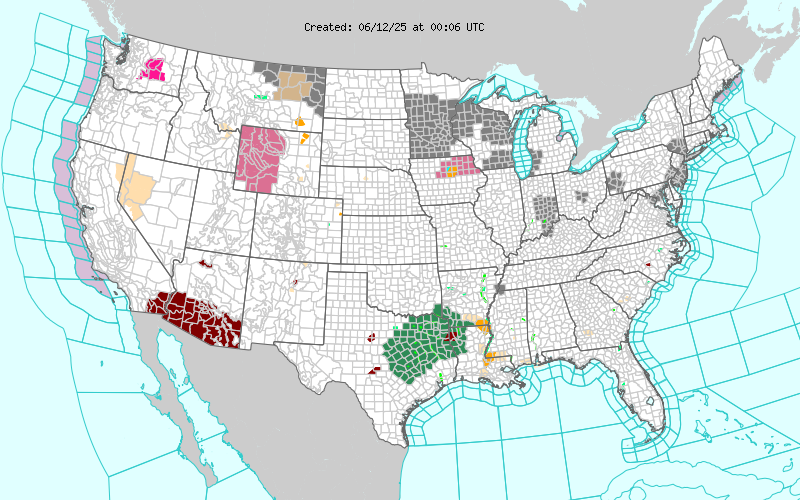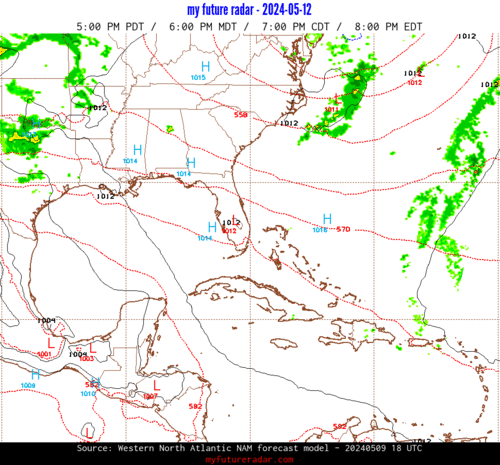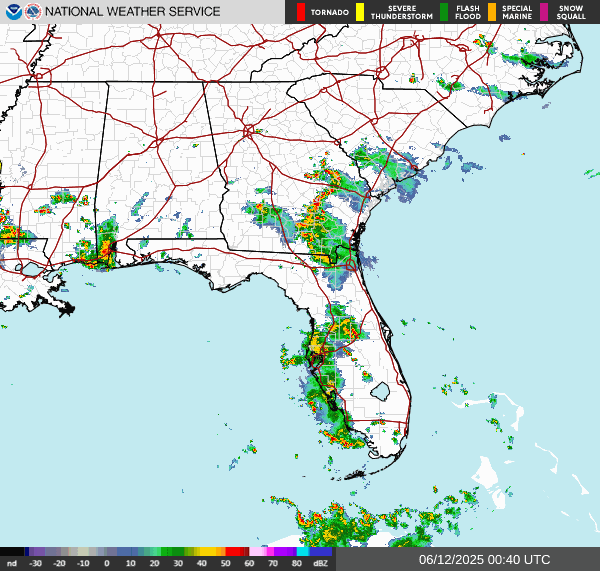Cyclocane
( cyclocane is a CYCLOne and hurriCANE tracker by hayley )
English Español Deutsch Français 日本語
This storm is unnamed. If the information appears to be out of date, its name may have changed, so visit the main page for the latest information.
PTC-ONE Current Status
Current Wind Speed 35 knots / 40 MPH
Max Predicted Wind Speed 45 knots / 50 MPH at
Current Watches/Warnings / Radar / Satellite
current US watches/warnings

live tornado/thunderstorm tracker - tornadohq
future radar imagery - my future radar
future radar imagery

(above image is an example of the Western North Atlantic page - see Atlantic future radar page for a full set of images)
If a tropical storm or hurricane is threatening land, you can check my future radar for an idea of what radar might look like as the storm approaches.
PTC-ONE Land Hazards
NWS Local Hurricane Statements
Corpus Christi TX AL012024 **Tropical Storm Warnings Remain in Effect**Brownsville TX AL012024 ***TROPICAL STORM WARNING NOW IN EFFECT***
- RAINFALL - Potential Tropical Cyclone One is expected to produce rainfall totals of 5 to 10 inches across northeast Mexico into South Texas, with maximum totals of 15 inches possible. This rainfall will likely produce flash and urban flooding along with new and renewed river flooding. Mudslides are also possible in areas of higher terrain across northeast Mexico.
- STORM SURGE - The combination of a dangerous storm surge and the tide will cause normally dry areas near the coast to be flooded by rising waters moving inland from the shoreline. The water could reach the following heights above ground somewhere in the indicated areas if the peak surge occurs at the time of high tide...
- WIND - Tropical storm conditions are expected within the warning area by tonight or Wednesday.
- TORNADOES - A couple of tornadoes may occur across parts of Deep South Texas on Wednesday.
- SURF - Swells generated by the disturbance will affect the coast of Texas and northeastern Mexico through Wednesday night. These swells are likely to cause life-threatening surf and rip current conditions. Please consult products from your local weather office.
PTC-ONE Tracker
PTC-ONE Satellite Loop
PTC-ONE Alternate Tracking Map
PTC-ONE Spaghetti Models
Spaghetti models for PTC-ONE can be found here:
PTC-ONE spaghetti models page »
PTC-ONE Watches and Warnings

Potential Tropical Cyclone PTC-ONE Tropical Cyclone Update
Potential Tropical Cyclone PTC-ONE Public Advisory
000 WTNT31 KNHC 181757 TCPAT1 BULLETIN Potential Tropical Cyclone One Intermediate Advisory Number 4A NWS National Hurricane Center Miami FL AL012024 100 PM CDT Tue Jun 18 2024 ...DISTURBANCE REMAINS LARGE BUT DISORGANIZED OVER THE WESTERN GULF OF MEXICO... ...HEAVY RAINFALL AND COASTAL FLOODING EXPECTED ALONG THE COASTS OF TEXAS AND NORTHEASTERN MEXICO OVER THE NEXT DAY OR TWO... SUMMARY OF 100 PM CDT...1800 UTC...INFORMATION ---------------------------------------------- LOCATION...22.0N 92.6W ABOUT 355 MI...570 KM ESE OF LA PESCA MEXICO ABOUT 405 MI...655 KM SE OF BROWNSVILLE TEXAS MAXIMUM SUSTAINED WINDS...40 MPH...65 KM/H PRESENT MOVEMENT...NNE OR 20 DEGREES AT 6 MPH...9 KM/H MINIMUM CENTRAL PRESSURE...999 MB...29.50 INCHES WATCHES AND WARNINGS -------------------- CHANGES WITH THIS ADVISORY: None. SUMMARY OF WATCHES AND WARNINGS IN EFFECT: A Tropical Storm Warning is in effect for... * the Texas coast from Port O'Connor southward to the mouth of the Rio Grande * the northeastern coast of Mexico south of the mouth of the Rio Grande to Puerto de Altamira. A Tropical Storm Warning means that tropical storm conditions are expected somewhere within the warning area within 36 hours. For storm information specific to your area in the United States, including possible inland watches and warnings, please monitor products issued by your local National Weather Service forecast office. For storm information specific to your area outside of the United States, please monitor products issued by your national meteorological service. DISCUSSION AND OUTLOOK ---------------------- At 100 PM CDT (1800 UTC), the disturbance was centered near latitude 22.0 North, longitude 92.6 West. The system is moving toward the north-northeast near 6 mph (9 km/h). A turn toward the northwest and west with an increase in forward speed is expected tonight and on Wednesday, and the system is forecast to reach the Gulf coast of Mexico by Wednesday night. Maximum sustained winds are near 40 mph (65 km/h) with higher gusts. Some increase in strength is likely during the next 36 hours, and the disturbance is forecast to become a tropical storm by Wednesday. * Formation chance through 48 hours...high...80 percent. * Formation chance through 7 days...high...80 percent. The disturbance is quite large, and satellite-derived wind data indicate that tropical-storm-force winds extend outward up to 415 miles (665 km) north of the center. The minimum central pressure based on Air Force Reserve dropsonde data is 999 mb (29.50 inches). HAZARDS AFFECTING LAND ---------------------- Key messages for Potential Tropical Cyclone One can be found in the Tropical Cyclone Discussion under AWIPS header MIATCDAT1 and WMO header WTNT41 KNHC. RAINFALL: Potential Tropical Cyclone One is expected to produce rainfall totals of 5 to 10 inches across northeast Mexico into South Texas, with maximum totals of 15 inches possible. This rainfall will likely produce flash and urban flooding along with new and renewed river flooding. Mudslides are also possible in areas of higher terrain across northeast Mexico. For a complete depiction of forecast rainfall and flash flooding associated with Potential Tropical Cyclone One, please see the National Weather Service Storm Total Rainfall Graphic, available at hurricanes.gov/graphics_at1.shtml?rainqpf and the Flash Flood Risk graphic at hurricanes.gov/graphics_at1.shtml?ero STORM SURGE: The combination of a dangerous storm surge and the tide will cause normally dry areas near the coast to be flooded by rising waters moving inland from the shoreline. The water could reach the following heights above ground somewhere in the indicated areas if the peak surge occurs at the time of high tide... Sargent, TX to Sabine Pass, TX...2-4 ft Galveston Bay...2-4 ft Mouth of the Rio Grande, TX to Sargent, TX...1-3 ft Sabine Pass, TX to Vermilion/Cameron Parish Line, LA...1-3 ft The deepest water will occur along the immediate coast near and to the north of the landfall location, where the surge will be accompanied by large and dangerous waves. Surge-related flooding depends on the relative timing of the surge and the tidal cycle, and can vary greatly over short distances. For information specific to your area, please see products issued by your local National Weather Service forecast office. For a complete depiction of areas at risk of storm surge inundation, please see the National Weather Service Peak Storm Surge Graphic, available at hurricanes.gov/graphics_at1.shtml?peakSurge. In Mexico, minor coastal flooding is possible north of where the center of the system crosses the coast in areas of onshore winds. WIND: Tropical storm conditions are expected within the warning area by tonight or Wednesday. TORNADOES: A couple of tornadoes may occur across parts of Deep South Texas on Wednesday. SURF: Swells generated by the disturbance will affect the coast of Texas and northeastern Mexico through Wednesday night. These swells are likely to cause life-threatening surf and rip current conditions. Please consult products from your local weather office. NEXT ADVISORY ------------- Next complete advisory at 400 PM CDT. $$ Forecaster Berg
Public Advisory not available for this storm.
Potential Tropical Cyclone PTC-ONE Forecast Discussion
612 WTNT41 KNHC 181449 TCDAT1 Potential Tropical Cyclone One Discussion Number 4 NWS National Hurricane Center Miami FL AL012024 1000 AM CDT Tue Jun 18 2024 The disturbance's overall envelope is becoming slightly better defined, although there is still no evidence that a well-defined center of circulation has developed. Deep convection is increasing somewhat near the estimated center, but the most widespread activity is blossoming farther north over the northwestern Gulf of Mexico. The system is still being designated as a potential tropical cyclone with 35-kt winds, and an Air Force Reserve reconnaissance aircraft is currently surveying the system's wind field to assess its structure. The disturbance is moving generally northward, or 005/6 kt, although the centroid of the cloud pattern suggests it may have jogged east a bit. A continued slow motion is expected through tonight as the system gradually consolidates, but a turn toward the west with an increase in forward speed is forecast Wednesday and Wednesday night due to a mid-level ridge building southwestward over the southeastern United States. The updated NHC track forecast is similar to the previous one during the first 24 hours, but is then a bit faster after that, trending toward the HCCA and TVCA consensus aids. The system's broad nature will continue to inhibit significant strengthening despite otherwise conducive environmental conditions. Global model fields suggest the circulation will tighten up and develop a well-defined center on Wednesday while the system approaches the coast of Mexico. Intensification becomes more of a possibility at that point, and gradual strengthening is forecast on Wednesday while the system approaches the coast. It should be noted that regardless of the exact track of the low, we expect this system to have a large area of heavy rains, moderate coastal flooding and tropical-storm-force winds well north of the center. The official wind speed probabilities are likely underestimating the chances of tropical-storm-force winds along the Texas coast because of the unusually large and asymmetric area of strong winds on the northern side of the circulation. Key Messages: 1. Users are reminded not to focus on the exact forecast track of this system. The disturbance is very large with rainfall, coastal flooding, and wind impacts likely to occur far from the center along the coasts of Texas and northeastern Mexico. 2. Rainfall associated with Potential Tropical Cyclone One will impact large regions of Central America, north across northeastern Mexico and into South Texas. This rainfall will likely produce considerable flash and urban flooding along with new and renewed river flooding. Mudslides are also possible in areas of higher terrain across Central America into Northeast Mexico. 3. Moderate coastal flooding is likely along much of the Texas Coast beginning today and continuing through midweek. 4. Tropical storm conditions are expected to begin tonight or Wednesday along portions of the Texas coast south of Port O’Connor and along portions of the coast of northeastern Mexico within the Tropical Storm Warning area. FORECAST POSITIONS AND MAX WINDS INIT 18/1500Z 21.8N 92.7W 35 KT 40 MPH...POTENTIAL TROP CYCLONE 12H 19/0000Z 22.5N 93.3W 35 KT 40 MPH...POTENTIAL TROP CYCLONE 24H 19/1200Z 23.0N 95.2W 40 KT 45 MPH...TROPICAL CYCLONE 36H 20/0000Z 23.3N 97.5W 45 KT 50 MPH...TROPICAL CYCLONE 48H 20/1200Z 23.3N 100.3W 30 KT 35 MPH...INLAND 60H 21/0000Z...DISSIPATED $$ Forecaster Berg
PTC-ONE storm path from NHC
| Time | Speed | Location | Status |
|---|---|---|---|
| 35 knots | 22.0, -92.6 | ||
| 35 knots | 22.5, -93.3 | translation missing: en.POTENTIAL TROP CYCLONE | |
| 40 knots | 23.0, -95.2 | TROPICAL CYCLONE | |
| 45 knots | 23.3, -97.5 | TROPICAL CYCLONE | |
| 30 knots | 23.3, -100.3 | translation missing: en.INLAND | |
| 0 knots | translation missing: en.DISSIPATED |
site by Hayley Croft
Hi, I'm Hayley. Did you know that I run this site out of my own pocket? So if you'd like to help support this site:
- Tell your friends about Cyclocane
- Buy something through this Amazon Cyclocane link
- make a donation - totally optional but completely appreciated
Make a monthly donation or a one-time donation to help support ongoing costs with Cyclocane.
Play solitaire and track all of the cyclocane storms at the same time at Hurricane Solitaire.


